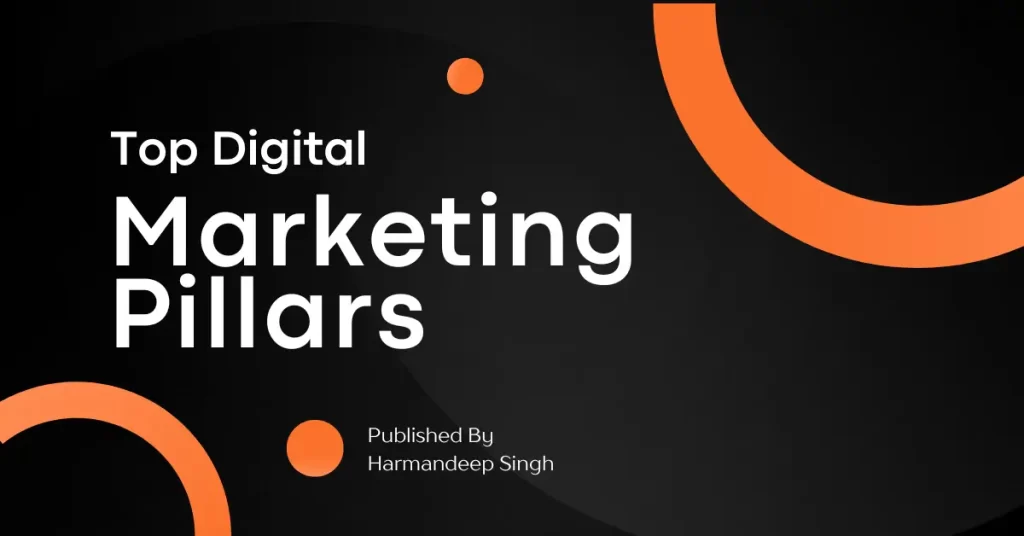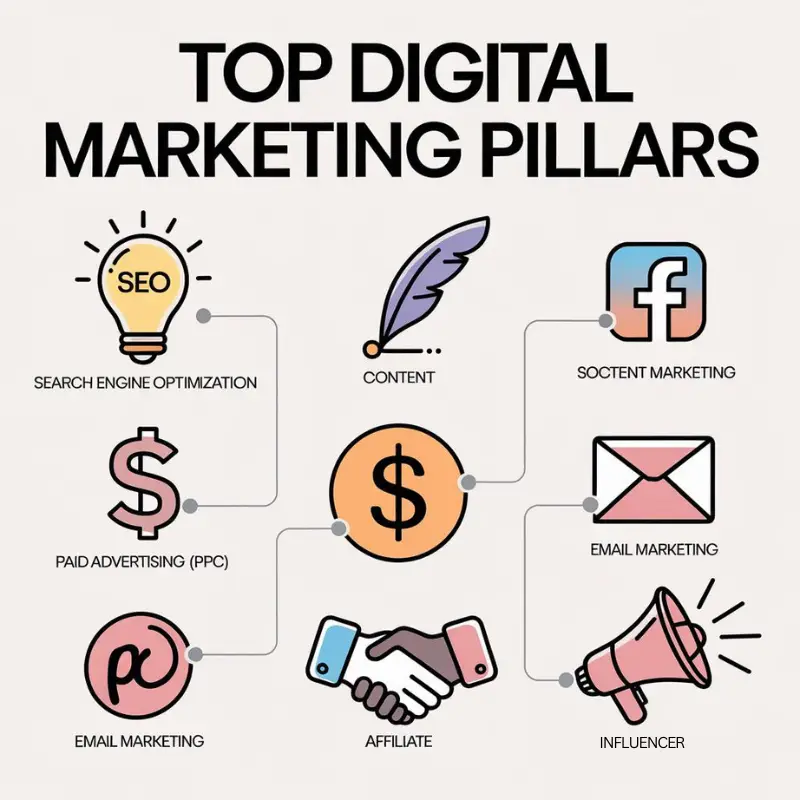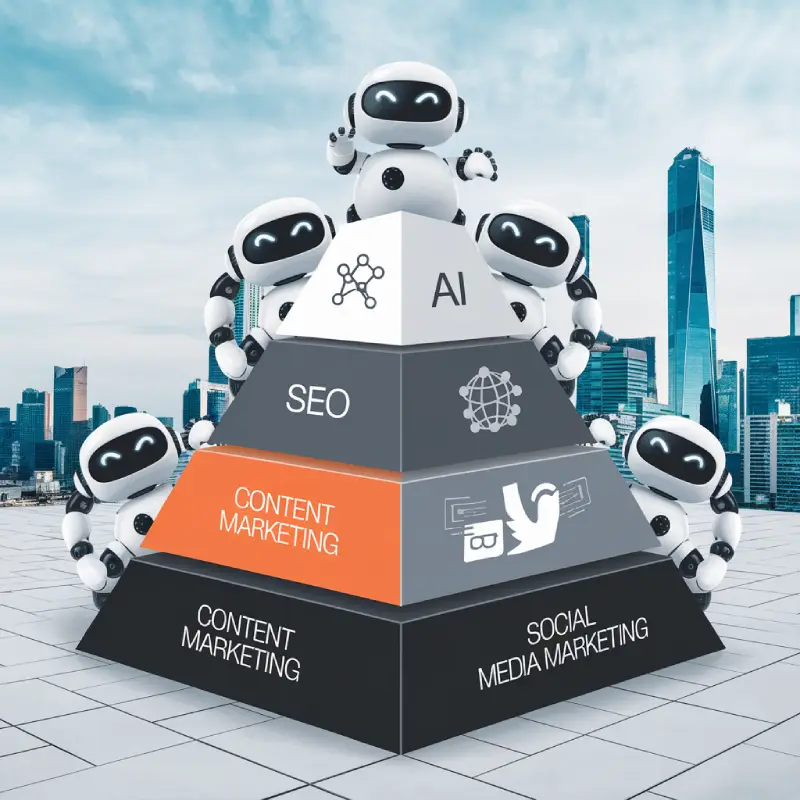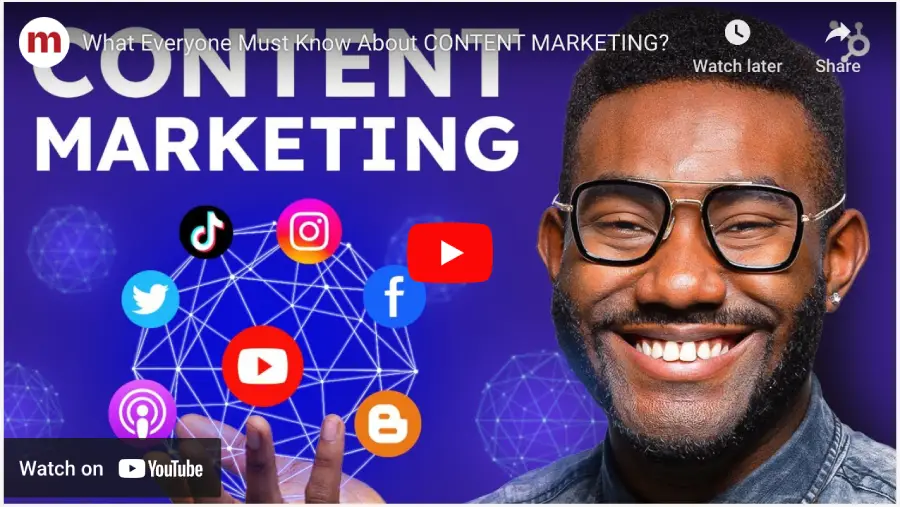Digital marketing has become essential for every business, regardless of size or industry.
But how many main pillars of digital marketing are there, and what do they encompass?

Understanding these pillars can help you create a well rounded strategy that drives traffic, increases leads, and boosts conversions.
In this guide, we will explore the seven primary pillars of digital marketing and discuss whether Artificial Intelligence (AI) is emerging as one of these core elements.
Introduction to Digital Marketing
Digital marketing refers to all online strategies that companies use to reach and engage their audience. From search engines and social media platforms to email campaigns and paid ads, digital marketing offers a wide array of tools to grow your business.
But how many main pillars of digital marketing are there? Typically, digital marketing can be broken down into seven key pillars, which are foundational to any successful online strategy.
What Are the Pillars of Digital Marketing?
The pillars of digital marketing include strategies and tools that help businesses attract customers, generate leads, and drive conversions. While these tactics can function independently, they yield the best results when combined into a unified approach.

Pillar 1:
Search Engine Optimization (SEO)
SEO is the process of optimizing your website to improve its ranking in search engine results pages (SERPs). When your website appears higher in search results, it attracts more organic traffic users who are actively searching for information, products, or services related to your business.
SEO involves both on-page optimization (like keyword research and content creation) and off-page efforts (like link building). Technical SEO, which focuses on improving website speed, mobile-friendliness, and site architecture, is also critical for ranking. For a deeper dive into SEO strategies and best practices, consider enrolling in our SEO Course.
Key Components of SEO:
- Keyword research
- On-page SEO (titles, meta tags, headers)
- Off-page SEO (link building)
- Technical SEO (site speed, mobile optimization)
- Local SEO for businesses with physical locations
Pillar 2:
Content Marketing
Content marketing focuses on creating valuable, relevant, and consistent content to attract and engage your target audience. Whether through blog posts, e-books, videos, or infographics, the goal of content marketing is to inform and educate your audience while driving traffic and conversions.
Content marketing is often tightly aligned with SEO because search engines favor high-quality, informative content. When your content is well-optimized, it helps you rank higher for relevant keywords, driving more traffic to your site.
Content Marketing Strategies:
- Blog posts and articles
- Case studies and whitepapers
- Infographics and visual content
- Video content (tutorials, explainer videos)
- Webinars and podcasts
Pillar 3:
Social Media Marketing
Social media marketing involves using platforms like Facebook, Instagram, Twitter, LinkedIn, and TikTok to engage with your audience, build brand awareness, and drive traffic to your website.
With billions of users worldwide, social media offers an incredible opportunity to reach new customers and stay connected with existing ones.
Social media marketing includes both organic posting and paid advertising.
A strong social media strategy will leverage both to increase engagement and drive conversions. To master the art of running effective paid ads on Facebook, consider enrolling in our Facebook Ads Course.
Social Media Marketing Tactics:
- Posting engaging content (videos, images, stories)
- Running paid ads on social platforms
- Engaging with followers through comments, direct messages, and shares
- Influencer collaborations for wider reach
Pillar 4:
Paid Ads (Pay Per Click)
Pay-Per-Click (PPC) advertising allows you to display ads on search engines (like Google and Bing) and social media platforms.
Unlike SEO, which takes time to build, PPC delivers immediate results by paying for clicks or impressions. To dive deeper into creating effective PPC campaigns, consider enrolling in our Pay-Per-Click Course
Google Ads is one of the most popular PPC platforms. It enables businesses to bid on specific keywords and display ads at the top of search results.
The advantage of PPC is that you can target highly specific audiences based on location, behavior, and interests.
Benefits of PPC:
- Immediate visibility and traffic
- Highly targeted campaigns
- Full control over ad spend
- Easy to measure and track ROI
Pillar 5:
Email Marketing
Email marketing remains one of the most effective digital marketing tools.
It involves sending targeted messages to a list of subscribers or customers to promote products, share news, or nurture leads.
Email marketing allows businesses to maintain a direct line of communication with their audience, fostering loyalty and repeat business.
With advanced segmentation and personalization, email campaigns can deliver highly relevant content that speaks directly to the needs and interests of your audience.
Email Marketing Tactics:
- Building and segmenting email lists
- Personalization and automation (e.g., drip campaigns)
- Optimizing subject lines and content for higher open rates
- Measuring open rates, click-through rates, and conversions
Pillar 6:
Affiliate Marketing
Affiliate marketing is a performance based marketing strategy where businesses partner with affiliates (individuals or companies) who promote their products or services in exchange for a commission.
Affiliates use blog posts, social media, email, or other channels to drive traffic to a business’s website.
Affiliate marketing expands your reach by leveraging other people’s audiences. It’s an effective way to increase brand exposure and sales without a large upfront investment.
How Affiliate Marketing Works:
- Affiliates promote your product via their online channels
- You pay a commission for each lead or sale they generate
- It allows for scalable marketing efforts
Pillar 7:
Influencer Marketing
Influencer marketing involves collaborating with influencers people with large followings on platforms like Instagram, YouTube, or TikTok to promote your products or services. Influencers help you tap into new audiences and lend credibility to your brand by endorsing your offerings.
The success of influencer marketing depends on selecting influencers who align with your brand values and have a genuine connection with their audience.
Key Influencer Marketing Strategies:
- Partnering with influencers for product reviews and endorsements
- Collaborating on sponsored content or giveaways
- Tracking engagement and conversions from influencer campaigns
Is AI One of the Pillars of Digital Marketing?
With the rise of Artificial Intelligence (AI) and machine learning, many wonder whether AI should be considered one of the pillars of digital marketing. While AI may not yet be a standalone pillar, its impact on digital marketing is undeniable. This article from Microsoft explores how AI can unlock breakthrough creativity, further demonstrating its influence in marketing strategies.
AI is revolutionizing how businesses approach digital marketing by providing personalized user experiences, automating tasks, and predicting customer behavior.
AI-powered tools are now widely used for chatbots, customer service, content generation, email automation, and more.
How AI Is Transforming Digital Marketing:
- Personalization at scale (e.g., product recommendations)
- Automated customer interactions through AI chatbots
- AI-driven content creation and optimization
- Predictive analytics for smarter marketing decisions
While AI is currently more of a supporting tool than a primary pillar, its role in shaping the future of digital marketing is significant. As AI continues to advance, we may see it become a more prominent pillar in the coming years.

How Do These Pillars Work Together?
Each digital marketing pillar works independently, but they are most powerful when integrated.
For example, SEO helps drive organic traffic, which can be nurtured through content marketing and email campaigns. Social media amplifies your content, while paid ads provide immediate visibility and conversions.
A successful digital marketing strategy involves using these pillars in combination, ensuring that all aspects work together to create a seamless customer journey.
Importance of Measuring and Analyzing Results
Digital marketing is constantly evolving, and staying updated on emerging trends is crucial for success.
Aside from AI, trends like voice search optimization, video marketing, and augmented reality (AR) are becoming increasingly important.
As consumer behavior shifts and technology advances, businesses must adapt their strategies to stay competitive.
Choosing the Right Pillars for Your Business
Not every business needs to invest equally in all seven pillars. Depending on your goals and audience, some pillars may be more relevant than others.
For example, a B2B company might focus on SEO and content marketing, while a direct to consumer brand may prioritize social media and PPC.
It’s important to align your marketing strategy with your business objectives and target audience to achieve the best results.
How to Stay Updated on Digital Marketing Pillars?
Digital marketing is dynamic, with new tools and strategies emerging all the time. To stay ahead, businesses must continuously learn and adapt.
Subscribing to industry blogs, attending webinars, and participating in online courses are great ways to stay updated on the latest trends and best practices.
So, how many main pillars of digital marketing are there?
The answer is seven, each critical to a comprehensive digital strategy. From SEO and content marketing to email and influencer marketing, these pillars work together to drive traffic, leads, and conversions.
While Artificial Intelligence (AI) may not yet be a formal pillar, it plays an increasingly influential role in shaping the future of digital marketing. As technology evolves, staying informed and adaptable will ensure your digital marketing efforts remain effective and competitive.
To master these essential digital marketing pillars and more, enroll in the DSDM Digital Marketing Course today!

